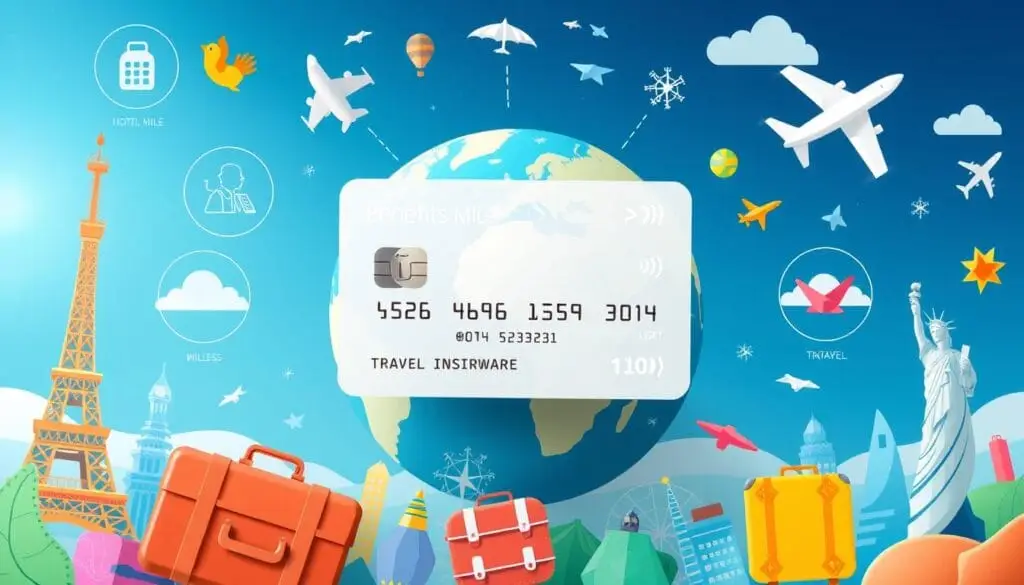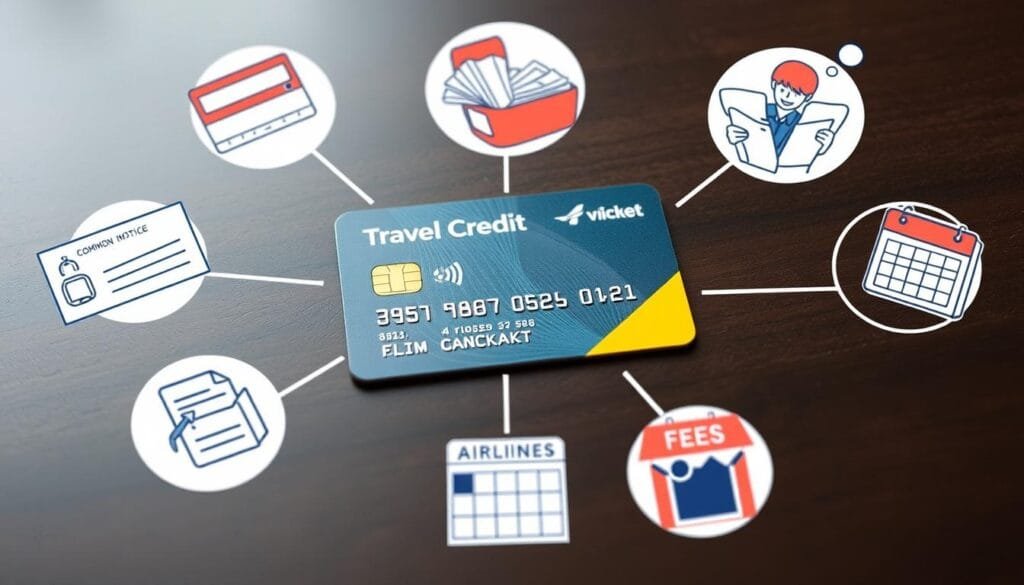Affiliate Disclosure: Travel with Plastic may earn a commission or referral bonus from some links on this site. These affiliate links help support our work and may influence the placement or promotion of certain products or services. However, our content is independently crafted to reflect honest opinions. Not all offers or products are included. There is no additional cost to users when they utilize our affiliate links.
Did you know that 75% of travel credit card users miss out on $300 in rewards yearly? This fact shows why it’s crucial to maximize your credit card rewards. Let’s explore how to avoid common pitfalls in travel hacking.
We’ll guide you through travel credit card usage. Our goal is to ensure you don’t miss out on valuable rewards.
Travel credit cards can transform your journeys. They offer perks like discounted first-class flights and free hotel elite status. These benefits can greatly enhance your travel experience.
To truly benefit, you need to know how to use these cards wisely. Let’s explore strategies to avoid common mistakes with travel credit cards.
Key Takeaways
- Meet minimum spending requirements to secure welcome bonuses
- Understand point values across different redemption options
- Maximize category bonuses for optimal point earning
- Be aware of annual fees and associated benefits
- Stay informed about point expiration policies
- Strategically time your credit card applications
- Choose cards that align with your travel goals
Understanding Welcome Bonus Requirements
Travel credit cards offer enticing sign-up bonuses for your next adventure. These offers require careful consideration. Let’s explore key aspects for successful points redemption and responsible credit use.
Minimum Spending Thresholds
Welcome bonuses typically require spending a set amount within a specific timeframe. The Platinum Card from American Express offers 80,000 points after spending $8,000 in six months.
That’s about $1,333 per month. Assess your regular spending before applying. Ensure you can meet the threshold without financial strain.
Time Limitations for Bonus Qualification
The countdown begins once you’re approved for the card. Missing the deadline means forfeiting the bonus. Some cards give three months, while others offer six.
Plan your purchases strategically to meet the spending requirement on time. This approach helps you secure the valuable bonus points.
Excluded Transactions
Not all purchases count towards the minimum spend. Common exclusions are balance transfers, cash advances, annual fees, and interest charges.
Always read the fine print to understand what qualifies. Focus on everyday spending and planned purchases to meet the threshold responsibly.
- Balance transfers
- Cash advances
- Annual fees
- Interest charges
| Card | Welcome Bonus | Spending Requirement | Time Frame |
|---|---|---|---|
| Amex Platinum | 80,000 points | $8,000 | 6 months |
| Chase Sapphire Preferred | 60,000 points | $4,000 | 3 months |
| Capital One Venture | 75,000 points | $4,000 | 3 months |
Sign-up bonuses can provide $750 to $1,000+ in travel value per card. Understanding these requirements helps maximize your rewards.
You’re now equipped to make informed decisions about credit card bonuses. Happy travels and smart spending!
Smart Point Redemption Strategies
Unlocking the full potential of travel credit card rewards requires smart point redemption. Let’s dive into strategies that squeeze the most value from your points.
Value Assessment for Points
Point redemptions vary greatly in value. American Express Membership Rewards points can be worth 0.5 cents for gift cards. However, strategic use can boost their value to 1.2 cents.
Always compare redemption options before spending your points. This simple step ensures you’re getting the best deal possible.
Transfer Partner Opportunities
Transferring points to airline miles or hotel programs often yields the highest value. For example, 50,000 miles could get you a one-way business class seat to Singapore.
This approach can significantly increase your points’ worth compared to standard redemptions. It’s a smart way to maximize your travel rewards.
Best Times to Use Points
Timing is crucial when redeeming points. Consider these strategies:
- Book during off-peak seasons to save on point costs
- Look for promotional deals that reduce point requirements
- Combine points across multiple loyalty programs to reach thresholds faster
These smart redemption strategies can stretch your points further. You’ll enhance your travel experiences without unnecessarily depleting your balance.
| Redemption Method | Value per Point | Best Use Case |
|---|---|---|
| Gift Cards | 0.5 cents | Last resort option |
| Statement Credit | 0.6 cents | Quick cash back |
| Travel Portal Bookings | 1.0 cents | Convenient travel booking |
| Transfer Partners | 1.2+ cents | Luxury travel, maximum value |
Avoid These Common Mistakes When Using Travel Credit Cards
Travel credit cards offer great perks, but can be tricky to use. Let’s look at some common pitfalls and smart habits to boost your rewards.
A big mistake is missing out on card benefits. Many cards have yearly travel credits or free hotel stays. These often expire, so keep track of them.
The Delta SkyMiles Gold Card’s fee rises from $99 to $150 after year one. But checking bags on three round trips saves $210, making it worth it.
Poor timing of applications is another issue. Chase’s 5/24 rule limits new cards if you’ve opened five in 24 months. Consider this in your rewards plan.
- Neglecting business card options
- Ignoring retention offers
- Failing to explore downgrade or upgrade paths
To avoid credit card pitfalls, try these smart habits:
- Track your card benefits and use them before they expire
- Plan your card applications strategically
- Explore business card options if you have a side hustle
- Ask about retention offers before canceling a card
- Consider downgrading to a no-fee card to maintain account history
These practices will help you get the most from your travel rewards. A good strategy can lead to big savings and better trips.
Maximizing Category Bonuses and Rewards
Smart credit card use can boost your travel opportunities. By using cards strategically, you’ll earn points faster for your dream trips. Let’s explore how to maximize rewards and master travel hacking.
Optimal Card Selection for Different Purchases
Choosing the right card for each purchase boosts rewards. Some cards offer 3x points on travel and dining. Others give better rewards for groceries or gas.
Match your spending to the right card. This way, you’ll earn more points on every dollar spent.
| Category | Best Card Type | Potential Rewards |
|---|---|---|
| Travel | Travel Rewards Card | Up to 3x points |
| Dining | Dining Rewards Card | Up to 3x points |
| Groceries | Grocery Rewards Card | Up to 5x points |
| Gas | Gas Rewards Card | Up to 4x points |
Bonus Category Tracking
Tracking bonus categories across multiple cards can be challenging. Create a spreadsheet or use an app to track best rewards. This ensures you never miss out on bonus points.
Seasonal Promotion Strategies
Many cards offer seasonal promotions to boost rewards earnings. Watch for limited-time offers and plan your spending accordingly. You might find extra points for holiday shopping or summer travel bookings.
Responsible credit use is key to successful travel hacking. Always pay your balance in full each month. This avoids interest charges that can cancel out your rewards.
With smart planning and strategic spending, you’ll soon be on your next adventure!
Managing Annual Fees Effectively
Annual fees are crucial when picking travel credit cards. Smart management of these fees is essential for responsible card use. Let’s explore ways to offset costs and maximize benefits.
Many popular travel cards charge a $95 annual fee. The Chase Sapphire Preferred and Capital One Venture Rewards are examples. Savvy cardholders can easily recover this cost through smart use of perks.
To justify the fee, use benefits like free checked bags or hotel elite status. A single free checked bag can save more than the annual fee in one trip.
| Card Benefit | Potential Value |
|---|---|
| Free Checked Bag | $30-$60 per flight |
| Hotel Elite Status | $100+ in upgrades and perks |
| Anniversary Night | $150-$300 hotel stay |
Many cards waive the annual fee for the first year. This gives you time to assess its value. If you’re not benefiting, consider downgrading or canceling the card.
Be careful when closing a card. It can affect your credit utilization ratio. This could impact up to 30% of your credit score.
Regularly analyze the cost-benefit of your cards. This ensures you’re getting the most value from your annual investments. It also helps avoid unnecessary credit card fees.
Understanding Card Benefits and Perks
Travel credit cards offer more than just rewards points. Many include valuable perks that enhance your travel experience. These benefits can save you money and improve your trips.
Travel Insurance Coverage
Comprehensive travel insurance is a key benefit of many cards. This can cover trip cancellation, delay protection, and lost luggage reimbursement. The Chase Sapphire Reserve® offers up to $20,000 per trip for cancellation insurance.
Airport Lounge Access
Premium travel cards often provide free airport lounge access. The Platinum Card® from American Express grants entry to over 1,400 lounges worldwide. This perk can make long layovers more comfortable and save money on airport food.
Hotel Status Benefits
Some cards upgrade your hotel status automatically. This can give you perks like late check-out, room upgrades, and free breakfast. These benefits can greatly improve your stay and save you money.
| Card | Annual Fee | Key Benefits |
|---|---|---|
| Chase Sapphire Reserve® | $550 | $300 annual travel credit, 10x points on hotels and car rentals |
| Amex Platinum Card® | $695 | Extensive lounge access, hotel status upgrades |
Knowing these perks helps you avoid common credit card errors. It also helps you get the most from your travel rewards. Not using these benefits is a big mistake.

Use apps like Travel Freely or AwardWallet to track your benefits. These tools help you use all your card’s perks. They ensure you’re not missing out on valuable rewards.
Foreign Transaction Fee Considerations
Travel hacking requires avoiding credit card pitfalls like foreign transaction fees. These fees can silently eat into your travel budget. They typically range from 1% to 3% of each purchase made abroad.
Let’s examine the impact of these fees. Spending $400 in Italy with a 2% fee would cost an extra $8. Over a week or two, these charges can add up quickly.
| Spending Amount | Fee Percentage | Additional Cost |
|---|---|---|
| $400 | 2% | $8 |
| $1000 | 2% | $20 |
| $2000 | 2% | $40 |
Many travel credit cards waive these fees. Choosing the right card can save you about 3% on every foreign purchase. Some cards offer rewards that can save you hundreds annually.
About 25% of credit card offers don’t include foreign transaction fees. Be cautious of dynamic currency conversion offered by foreign banks. It often comes with unfavorable rates and hidden fees.
“Using credit cards to convert currency while traveling abroad can save users up to 8% compared to services that convert hard currency.”
Understanding these factors helps you maximize your travel budget. You can enjoy international adventures without worrying about sneaky fees. Always pay in local currency to avoid unnecessary costs.
Strategic Timing for Card Applications
Smart timing of credit card applications boosts travel rewards. It also minimizes credit score impact. Let’s explore key factors for your next card application.
Credit Score Considerations
Credit scores range from 300 to 850. Higher numbers show better creditworthiness. Payment history affects 35% of your score.
Always pay on time to maintain a good score. Keep credit utilization below 30%. New credit inquiries can temporarily lower your score slightly.
Navigating Bank Rules
Banks have specific application rules. Chase’s “5/24 rule” limits welcome bonuses for frequent applicants. American Express has a “once-per-lifetime” bonus rule for each card.
Understanding these policies helps plan applications strategically. Knowing bank rules improves your chances of approval.
Timing Bonus Offers
Welcome bonuses often start at 50,000 points or more. They usually require spending over three months. Watch for peak bonus periods during holidays or travel seasons.
Some cards offer extra spend-based bonuses. These allow you to earn more points on top of regular rewards.
“Missing a decent welcome bonus offer because you didn’t apply at the right time is a mistake that could cost you valuable perks, points, and miles.”
Align applications with these factors to build a strong card portfolio. Maintain a healthy credit score while doing so.
Effective travel hacking needs careful planning. Understanding credit dynamics is key to success.
Point Expiration and Protection

Airline miles and hotel loyalty programs are valuable assets for travel enthusiasts. Losing hard-earned points due to expiration can be frustrating. Let’s explore ways to keep your rewards active and protected.
Most loyalty programs have expiration policies. Typically, you need to earn one point every 18-36 months to keep your account active. This includes miles earned through credit card spending.
Here’s a quick look at some popular loyalty program expiration policies:
| Program | Expiration Policy | Extension Option |
|---|---|---|
| ANA Mileage Club | 36 months after earning | No extension allowed |
| Emirates Skywards | 3 years after earning | $20 per 1,000 miles for 1 year |
| Singapore KrisFlyer | 36 months after earning | $12 per 10,000 miles for 6 months |
| Wyndham Rewards | 18 months of inactivity | 4 years from earning |
To protect your points, try these strategies:
- Use a rewards credit card for small purchases
- Earn points through dining programs
- Transfer points between programs
- Donate a small number of points to charity
Business and first-class international flights offer the best value for airline miles. Keep your points active to be ready for that dream luxury trip.
Choosing the Right Card Portfolio
A smart credit card portfolio maximizes rewards and avoids travel mistakes. Your card selection should match your travel goals and spending habits. This ensures you get the most value from your cards.
Travel Goals Alignment
Know your travel preferences before choosing cards. Do you like luxury hotels or budget options? Are you loyal to one airline?
Your answers will guide your card choices. For example, a United Airlines card might suit you better if you often fly United.
Complementary Card Benefits
Pairing cards strategically can boost your rewards. Consider these statistics:
- 1% cash back on all purchases with a basic Visa card
- 4x points on supermarket and restaurant purchases with American Express Gold
- 5x points on airfare and hotels with American Express Platinum
Combining these cards maximizes rewards across different spending categories. This strategy can increase your bonuses by 30% for savvy travelers.
Only 20% of cardholders fully use their available rewards. Align your card portfolio with your travel goals and use complementary benefits.
You can join informed consumers who earn up to 50% more annually in credit card rewards.
Credit Card Retention Strategies
Smart credit card habits are crucial for responsible credit usage. Keeping valuable cards active helps maintain a strong rewards portfolio. It also helps avoid common credit card mistakes.
Always call your bank before canceling a card. Many issuers offer bonuses to keep your business. You might get a statement credit or bonus points.
Dr. Suzy Spadafora manages 20 credit cards. She often gets 15,000 Delta SkyMiles as a retention bonus.
Consider each card’s overall value. The American Express Platinum Card costs $695 yearly but offers $1,200 in benefits. Compare this to the Delta Platinum Amex.
The Delta card increased its fee to $350. However, it only offers 1X miles on Delta purchases.
I review my credit cards monthly to determine their retention value. It’s crucial for maximizing rewards and minimizing costs.
If no retention offer is available, consider downgrading to a no-fee version. This keeps your account active and preserves credit history. Closing a card can hurt your credit score.
It can increase your credit utilization ratio. It can also shorten your average account age.
| Retention Strategy | Potential Benefit |
|---|---|
| Request retention offer | Bonus points or statement credit |
| Downgrade to no-fee card | Preserve credit history |
| Evaluate card benefits | Justify annual fees |
| Time retention requests | Increase chance of success |
These strategies help maintain a strong card portfolio without extra costs. They can enhance your long-term travel rewards strategy.
Conclusion
Mastering travel rewards takes time and practice. A solid strategy combines smart credit card use with loyalty program knowledge. By avoiding pitfalls and maximizing rewards, you can unlock incredible travel experiences.
Remember key dates and spending thresholds. American Airlines Loyalty Points reset on March 1. Most airline metrics reset January 1. Some cards offer perks like qualifying night credits or elite status.
Stay informed about your credit score components. Credit utilization and debt each make up 30% of your score. Length of credit history accounts for 15%. Hard inquiries impact 10% of your score.
Apply for new cards strategically. Regularly reassess your card portfolio. This will help you navigate the evolving world of travel rewards. You’ll be well-equipped to make the most of your adventures.

